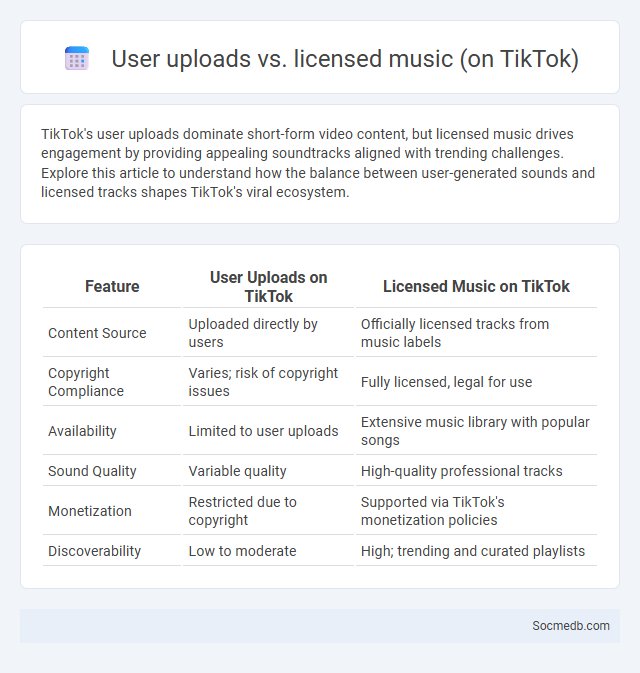
Photo illustration: User Uploads vs Licensed Music (on TikTok)
TikTok's user uploads dominate short-form video content, but licensed music drives engagement by providing appealing soundtracks aligned with trending challenges. Explore this article to understand how the balance between user-generated sounds and licensed tracks shapes TikTok's viral ecosystem.
Table of Comparison
| Feature | User Uploads on TikTok | Licensed Music on TikTok |
|---|---|---|
| Content Source | Uploaded directly by users | Officially licensed tracks from music labels |
| Copyright Compliance | Varies; risk of copyright issues | Fully licensed, legal for use |
| Availability | Limited to user uploads | Extensive music library with popular songs |
| Sound Quality | Variable quality | High-quality professional tracks |
| Monetization | Restricted due to copyright | Supported via TikTok's monetization policies |
| Discoverability | Low to moderate | High; trending and curated playlists |
Understanding User Uploads on TikTok
User uploads on TikTok consist primarily of short-form videos designed to capture attention within seconds, leveraging trends, hashtags, and soundtracks to enhance discoverability. TikTok's algorithm analyzes engagement metrics such as likes, shares, comments, and watch time to prioritize content in personalized For You feeds, promoting higher visibility for videos with strong user interaction. Creators optimize uploads by tailoring content to niche communities and participating in viral challenges, increasing the chances of algorithmic amplification and audience growth.
What Is Licensed Music on TikTok?
Licensed music on TikTok refers to songs and tracks that have been legally authorized for use on the platform through agreements with music rights holders, including record labels, publishers, and artists. This authorization allows TikTok users to incorporate popular and trending music in their videos without risking copyright infringement or content removal. TikTok's extensive library of licensed music offers varied genres and artists, enhancing creative expression while ensuring compliance with copyright laws and royalty payments.
Sound Copyright Explained
Sound copyright protects original audio recordings and compositions, granting creators exclusive rights to reproduce, distribute, and publicly perform their work on social media platforms. Platforms like YouTube, TikTok, and Instagram use automated content recognition systems such as Content ID and Audible Magic to detect unauthorized use of copyrighted audio. Users must obtain proper licenses or permissions to avoid copyright strikes, demonetization, or content removal, ensuring compliance with copyright law and protecting creators' intellectual property.
Key Differences: User Uploads vs Licensed Music
User uploads on social media typically involve individuals sharing original or personally curated content, allowing for diverse and spontaneous expression. Licensed music, however, is pre-approved by copyright holders and ensures legal compliance while offering high-quality audio tracks from established artists. This distinction impacts content monetization, copyright enforcement, and platform algorithms favoring either user-generated innovation or licensed consistency.
Legal Risks of Unauthorized Music Uploads
Unauthorized music uploads on social media platforms pose significant legal risks, including copyright infringement claims that can lead to hefty fines and platform account suspensions. Content creators and users must ensure they have proper licensing or explicit permission from rights holders to avoid violations of the Digital Millennium Copyright Act (DMCA) and related intellectual property laws. Platforms often employ automated content identification systems like Content ID to detect and remove unauthorized music, increasing the risk of legal consequences for infringing uploads.
Benefits of Using Licensed Music
Using licensed music on social media enhances content authenticity and ensures compliance with copyright laws, reducing the risk of takedown or legal issues. It elevates viewer engagement by aligning audio quality with brand identity and emotional tone. Access to a diverse library of licensed tracks enables creators to customize content, boosting overall visibility and reach across platforms.
TikTok’s Copyright Detection Systems
TikTok's copyright detection systems utilize advanced AI algorithms to identify and prevent unauthorized use of protected content, ensuring creators' rights are respected. Your videos are scanned for copyrighted music, video clips, and other proprietary materials, with automated matching technology flagging potential infringements in real-time. This system helps maintain a fair platform while encouraging original content creation and protecting intellectual property.
How Users Can Avoid Copyright Strikes
Users can avoid copyright strikes on social media by ensuring they share only original content or content with proper licensing and permissions. Utilizing royalty-free images, music, and videos from trusted platforms reduces the risk of infringement. Regularly reviewing platform guidelines and using built-in copyright tools helps maintain compliance and prevent account penalties.
Impact on Creators and the Music Industry
Social media platforms have transformed the music industry by enabling creators to reach global audiences directly, bypassing traditional gatekeepers like record labels. Viral trends and user-generated content on platforms such as TikTok and Instagram amplify song exposure, boosting streaming numbers and revenue for artists. This shift has democratized music promotion, empowering independent musicians while intensifying competition and altering revenue distribution across the industry.
Future Trends in TikTok Music Licensing
Future trends in TikTok music licensing will increasingly emphasize AI-driven rights management and blockchain technology to ensure transparent royalty distribution. TikTok is expanding partnerships with major record labels and independent artists, allowing your content to feature a broader spectrum of licensed music seamlessly. Enhanced data analytics will help creators optimize music selection for audience engagement while respecting copyright compliance.
 socmedb.com
socmedb.com